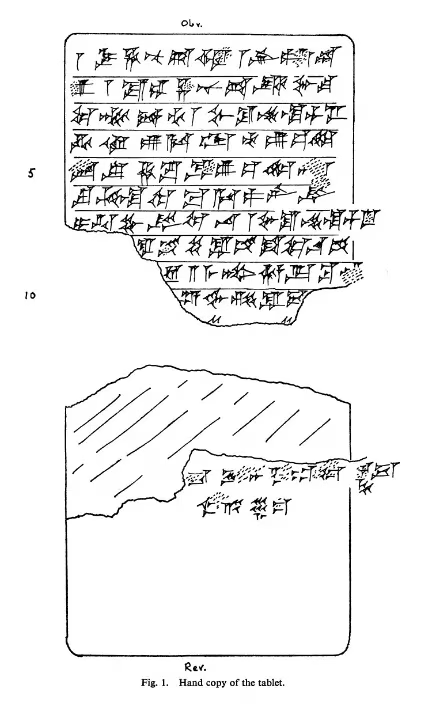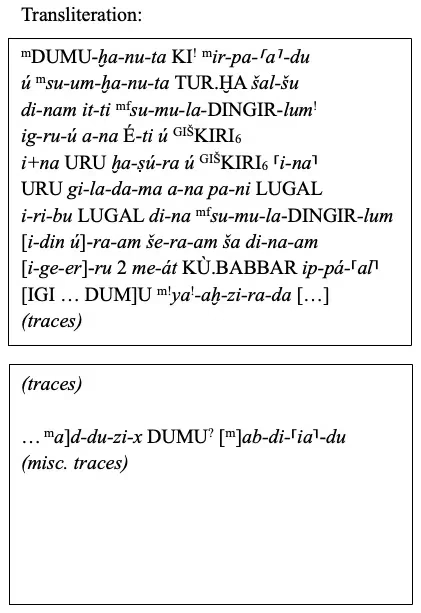The PhD comprehensive exams for HB/NWS students consist of four sections: (1) Hebrew and Northwest Semitic languages; (2) biblical criticism; (3) Syro-Pal history; and (4) a minor language of study (mine is Akkadian). For my Akkadian comps, I’ve curated a reading list of about 50 texts for the “seen” portion of the exam (obviously I cannot prepare the “unseen” portion). This page includes some of my notes from the Akkadian reading list of primary sources. I’m responsible for knowing the cuneiform, transliterating, normalizing, and translating each passage. The passages for the exam may be given in copy or transliteration and may be accompanied by any relevant grammatical or historical questions.
Hazor 5: A Lawsuit from Middle Bronze Hazor
Line drawing

Basics
- Clay tablet; 4.7×5.2×2.5 cm
- Reg. No.: Israel Museum 75-240
- Date: Old Babylonian period; Late-Middle Bronze Age
- Language: Akkadian
- Find Information: Found in 1962 by a visitor to Tel Hazor (see Hallo and Tadmor 1977: 2, n. 7)
- Source: Oshima and Horowitz 2006, p. 69-70
Transliteration

Normalization
1 Bin-ḫanuta itti Irpadu 2 u Sum-ḫanuta ṣuḫārū šalšu 3 dīnam itti Sumu-la-ilum 4 igrû ana bīti u kirî 5 ina āli Ḥaṣora u kirî ina 6 Gilada-ma ana pāni šarri iribū šarru dīna Sumu-la-ilum 7 [idīn u]rram šēram ša dīnam 7 [iger]ru 2 me’at kaspi ippal. [ ] Yaḫzirada […] R [… A]ddu-zi.. mār Abdi-yadu.
My Translation
1 Bin-Anot with (Y)irpa-Addu 2 and Sum-Anot, three servants, 3 initiated a legal-case with Sumu-la-ilum 4b about a house and a garden 5 in the city of Hazor and a garden in 6 the city of Gil(e)ada. They came before the king. The king judged the legal-case (in favor of) Sumu-la-ilum. In the future, if one initiates a(nother) legal-case, he will pay 200 (shekels of) silver. [Witness: … the so]n of Yaḫzirada. R Addu-zi.., son of Abdi-yadu.
Previous Translations (selection)
Hallo and Tadmor 1977: “Mar-Ḫanuta and Irpa-Addu and Sum-Ḫanuta, three(?) servants(?), brought a lawsuit against the woman Sumu-la-ilu, in the matter of the house and orchard in the city Hazor and the orchard in the city Giladima. They came before the king for litigation. The king [judged] the case of the woman Sumu-la-ilu. Henceforth, whoever [shall bring] a lawsuit shall pay 200 (shekels?) of silver.” (Witnesses and date formula largely lost.)
Hallo 2003, “A Lawsuit from Hazor,” COS 3.120, pp. 269-270: “Mar-Hanuta and Irpa-Addu and Sum-Hanuta, three(?) servants(?), brought a lawsuit against the woman Sumu-la-ilu, in the matter of the house and orchard in the city Hazor and the orchard in the city Giladima. They came before the king for litigation. The king [judged] the case of the woman Sumu-la-ilu. Henceforth, whoever [shall bring] a lawsuit shall pay 200 (shekels?) of silver.” (Witnesses and date formula largely lost).
Horowitz and Oshima 2006 (line-by-line): “o1 Bin-Hanuta with Irpadu and Sum-Hanuta, three junior attendants, 3 a lawsuit against Sumulailum 4 initiated in regard to a home and a garden in the city of Hazor, and a garden in the city of Gilead?. Before the king, they came in. The king (in favour of) the case of Sumulailum rend[ered] judgement. Hereafter should anyone (another) lawsuit [initiat]e, he will make a supplementary payment of 200 (shekels) of silver. [Witness: … the so]n of Yahzirad[a, the? .] traces. r1 traces …] PN the son? of Abdiyadu […P]N re […] junior attendants.
Philological Commentary
Line 1 – No conjunction, either u or itti, is necessary to connect PN1 and PN2 if there are three or more listed. Thus, Oshima and Horowitz suggest a “special relationship” between the first two individuals may be indicated.
Line 2 – Oshima and Horowitz, following Hallo and Tadmor, take Ha-nu-ta in the two names to be for the goddess Anat (cf. Josh 15:59). Hallo and Tadmor read TUR.ḪA šal-šu at the end of line two, refering to three ṣuḫāru ‘junior attendants,’ a “class of people often attested to in the cuneiform west” (p. 72).
Line 3 – According to Hallo and Tadmor, the idiom dīnam itti PN + gerû (“to initiate proceedings against PN”) is well attested in both standard Babylonian and peripheral Akkadian, and it survived into the Aramaic legal formulary at Elephantine.
Line 7 – erēbu takes an e/i theme-vowel in the west, rather than Babylonian u (see Rainey 1999, p. 154).
Reverse – Hallo and Tadmor understand the PN as a phonetic rendering of Abdi-Addu ‘Servant of Addu’ (cf. Taanach 7 ii 12).
Vocabulary To Study
- gerû (ln. 4), G (i/i) “to be hostile to, attack”; leg. “initiate proceedings against”
- erēbu (ln. 7), G (Bab. u/u, Ass. a/u) “to enter, come in, go in, meet s.o.”
- urram šēram (ln. 8) – adverbial expression for “(If) in the future”
Bibliography
Takayoshi Oshima and Wayne Horowitz, “Hazor 5,” in Cuneiform in Canaan (Jerusalem: Israel Exploration Society, 2006), pp. 69-72.
Primary Publication:
Hallo and Tadmor 1977 (photo, pl. 1; copy, p. 3)
Studies:
Edzard 1985: 251; Anbar and Naʾaman 1986: 8–10; Malamat 1989: 56; Horowitz and Shaffer 1992a: 22, n. 4; Demsky 1990: 163; Naʾaman 1994: 176; Zadok 1996: 104; Rainey 1999: 154*; Goren 2000: 36; Rothenbusch 2000: 483–485; van der Toorn 2000: 98; Hallo 2002: 269–270; Naʾaman 2004: 92.